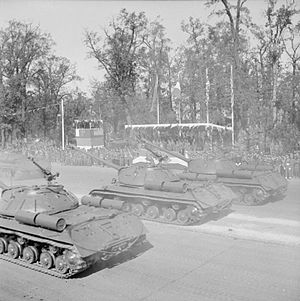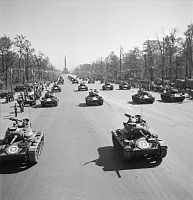
Georgy Konstantinovich Zhukov was a Marshal of the Soviet Union. He also served as Chief of the General Staff, Minister of Defence, and was a member of the Presidium of the Communist Party. During World War II, Zhukov oversaw some of the Red Army's most decisive victories. He was also a military governor of Germany succeeded by Wilhelm Pieck.

The Eastern Front was a theatre of World War II fought between the European Axis powers and Allies, including the Soviet Union (USSR) and Poland. It encompassed Central Europe, Eastern Europe, Northeast Europe (Baltics), and Southeast Europe (Balkans), and lasted from 22 June 1941 to 9 May 1945. Of the estimated 70–85 million deaths attributed to World War II, around 30 million occurred on the Eastern Front, including 9 million children. The Eastern Front was decisive in determining the outcome in the European theatre of operations in World War II, eventually serving as the main reason for the defeat of Nazi Germany and the Axis nations. It is noted by historian Geoffrey Roberts that "More than 80 per cent of all combat during the Second World War took place on the Eastern Front".

The Battle of Moscow was a military campaign that consisted of two periods of strategically significant fighting on a 600 km (370 mi) sector of the Eastern Front during World War II, between September 1941 and January 1942. The Soviet defensive effort frustrated Hitler's attack on Moscow, the capital and largest city of the Soviet Union. Moscow was one of the primary military and political objectives for Axis forces in their invasion of the Soviet Union.

Ivan Stepanovich Konev was a Soviet general and Marshal of the Soviet Union who led Red Army forces on the Eastern Front during World War II, responsible for taking much of Axis-occupied Eastern Europe.

Not to be confused with Konstantin Olkhovskii

The German Instrument of Surrender was a legal document effecting the unconditional surrender of the remaining German armed forces to the Allies, and ended World War II in Europe; the signing took place at 22:43 CET on 8 May 1945 and the surrender took effect at 23:01 CET on the same day.
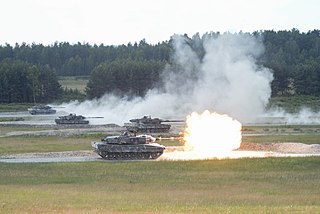
Armoured warfare or armored warfare, is the use of armoured fighting vehicles in modern warfare. It is a major component of modern methods of war. The premise of armoured warfare rests on the ability of troops to penetrate conventional defensive lines through use of manoeuvre by armoured units.

The Vistula–Oder offensive was a Red Army operation on the Eastern Front in the European theatre of World War II in January 1945. The army made a major advance into German-held territory, capturing Kraków, Warsaw and Poznań. The Red Army had built up their strength around a number of key bridgeheads, with two fronts commanded by Marshal Georgy Zhukov and Marshal Ivan Konev. Against them, the German Army Group A, led by Colonel-General Josef Harpe, was outnumbered five to one. Within days, German commandants evacuated the concentration camps, sending the prisoners on their death marches to the west, where ethnic Germans also started fleeing. In a little over two weeks, the Red Army had advanced 480 kilometres (300 mi) from the Vistula to the Oder, only 69 kilometres (43 mi) from Berlin, which was undefended. However, Zhukov called a halt, owing to continued German resistance on his northern flank (Pomerania), and the advance on Berlin had to be delayed until April.

The Race to Berlin was a competition between Soviet Marshals Georgy Zhukov and Ivan Konev to be the first to enter Berlin during the final months of World War II in Europe.
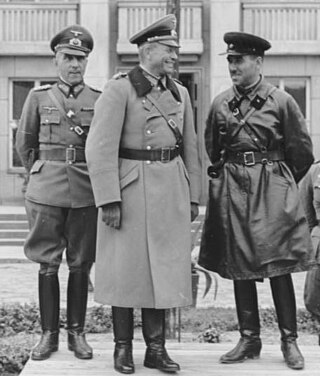
Semyon Moiseevich Krivoshein was a Soviet tank commander, who played a vital part in the World War II reform of the Red Army tank forces and in the momentous clash between German and Soviet tanks in the Battle of Kursk.

The 1945 Moscow Victory Parade also known as the Parade of Victors was a victory parade held by the Soviet Armed Forces after the defeat of Nazi Germany. This, the longest and largest military parade ever held on Red Square in the Soviet capital Moscow, involved 40,000 Red Army soldiers and 1,850 military vehicles and other military hardware. The parade lasted just over two hours on a rainy June 24, 1945, over a month after May 9, the day of Germany's surrender to Soviet commanders.
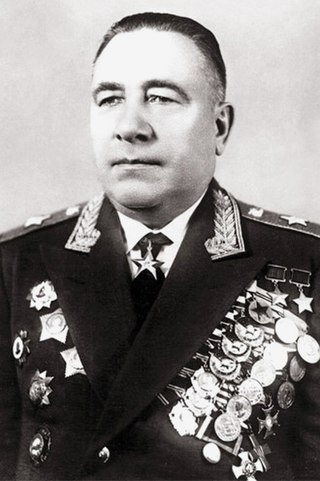
Marshal of Armoured Troops Mikhail Yefimovich Katukov served as a commander of armored troops in the Red Army during and following World War II. He is viewed as one of the most talented Soviet armor commanders. Mikhail Katukov holds the honor of the first major victory of the Soviet armored forces, the victory from October 4 to October 11, 1941 at Mtsensk over the 3rd and 4th tank divisions, which were part of the Guderian's Panzergruppe 2 in the Battle of Moscow. His other notable command during the German-Soviet War were that of 1st Guards Tank Army, which he commanded during the Battle of Kursk (1943), the Proskurov-Chernovtsy Operation (1944), the Lvov-Sandomierz Operation (1944), the Vistula Oder Operation (1945), and the Battle of Berlin (1945). He commanded 1st Guards Tank Brigade during the Battle of Moscow (1941), and 3rd Mechanised Corps during Operation Mars (1942).

The Soviet Banner of Victory was the banner raised by the Red Army soldiers on the Reichstag building in Berlin on 1 May 1945, the day after Adolf Hitler committed suicide. It was raised by three Soviet soldiers: Ukrainian Alexei Berest, Russian Mikhail Yegorov, and Georgian Meliton Kantaria.

Ivan Ivanovich Fedyuninsky was a Soviet military leader and Hero of the Soviet Union (1939).
Operation Solstice, also known as Unternehmen Husarenritt or the Stargard tank battle, was one of the last German armoured offensive operations on the Eastern Front in World War II.
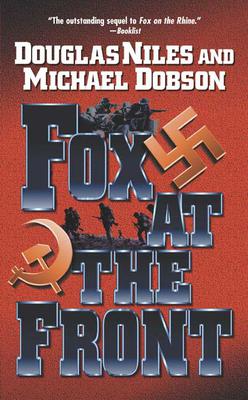
Fox at the Front is a 2003 alternate history novel written by Douglas Niles and Michael Dobson. It is a sequel to the 2000 novel Fox on the Rhine.
Grigory Nikolaevich Oriol was a Soviet armored corps general.

The New York City Victory Parade of 1946 was held in New York City, United States, on January 12, 1946, to celebrate the victorious conclusion of World War II.

The following events occurred in June 1945:

The IS-3 is a Soviet heavy tank developed in late 1944. Its semi-hemispherical cast turret became the hallmark of post-war Soviet tanks. Its pike nose design would also be mirrored by other tanks of the IS tank family such as the IS-7 and T-10. Too late to see combat in World War II, the IS-3 participated in the Berlin Victory Parade of 1945, in the border conflict during the Sino-Soviet split, the Soviet invasion of Hungary, the Prague Spring, on both sides during the Six-Day War, and in very limited capacity during the Russo-Ukraine War.
